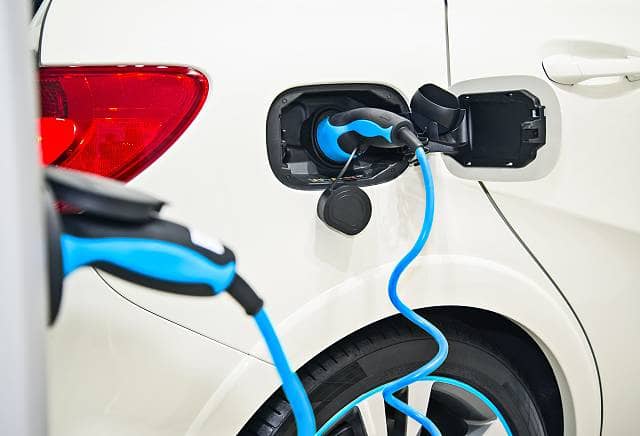Lithium plays a vital role in electric vehicles (EVs), with around 21-22% of all new cars sold in 2024 being fully electric. EVs now account for a significant portion of car sales in the UK, with a notable increase compared to previous years, driven by growing consumer interest, government incentives and advancements in charging infrastructure.
The global shift toward electric vehicles (EVs) represents one of the most significant transformations in the automotive industry in over a century. At the heart of this revolution is lithium, a critical element that powers the batteries in EVs.
As the world grapples with the challenges of climate change and the need for sustainable energy solutions, lithium has emerged as a key enabler of the transition to cleaner, greener transportation. This article explores the role of lithium in the electric vehicle revolution, its importance in battery technology and the future challenges and opportunities in this rapidly evolving market.
Lithium-ion batteries: The power behind electric vehicles
Lithium-ion batteries are the dominant technology used in electric vehicles today. These batteries are preferred over other types of rechargeable batteries due to their high energy density, long lifespan and ability to deliver consistent power. The energy density of lithium-ion batteries allows them to store more energy in a smaller, lighter package, which is crucial for the performance and range of electric vehicles.
The basic principle behind lithium-ion batteries involves the movement of lithium ions between the anode and cathode during charging and discharging cycles. This movement of ions generates the electrical energy needed to power the vehicle. The efficiency and reliability of this process have made lithium-ion batteries the standard for EVs, from compact cars to large trucks.
The importance of lithium in EV battery production
Lithium is a key component in the production of lithium-ion batteries, and its properties make it uniquely suited for this application. The lightest metal and the least dense solid element, lithium allows for the production of lightweight batteries that do not compromise on energy capacity.
This is particularly important in electric vehicles, where reducing weight is essential to maximising driving range and performance. It is therefore no surprise that lithium-ion batteries power the vast majority of electric vehicles, and with the growing shift to EVs, lithium demand is projected to increase by 500% by 2050, according to industry estimates.
Moreover, lithium’s electrochemical potential is one of the highest among metals, meaning it can store and release large amounts of energy. This characteristic is critical in ensuring that electric vehicles have enough power to accelerate quickly, maintain high speeds, and offer longer driving ranges on a single charge.
The demand for lithium has skyrocketed in recent years as the production of electric vehicles has increased. In 2023 alone, global EV sales reached new highs, and with each vehicle requiring a substantial amount of lithium for its battery pack, the pressure on lithium supply chains has intensified.
As of 2024, there are over 1.2 million electric vehicles (EVs) on UK roads. As a result, lithium prices are now more important than ever as this surge in demand has prompted significant investments in lithium mining and processing around the world, as countries and companies strive to secure their share of this essential resource.
Key lithium-producing regions
The majority of the world’s lithium supply comes from a few key regions, each with its own advantages and challenges in terms of production.
Australia is the world’s largest producer of lithium, primarily extracting it from spodumene, a lithium-rich mineral found in hard rock. The country’s well-developed mining infrastructure and stable regulatory environment have made it a reliable source of lithium for global markets.
South America, particularly the “Lithium Triangle” of Chile, Argentina, and Bolivia, is another major player in the lithium market. These countries produce lithium from vast salt flats, or salars, where lithium-rich brine is pumped to the surface and allowed to evaporate, leaving behind lithium carbonate. This method is generally less expensive than hard-rock mining, but it can be more environmentally and politically complex.
China is not only a significant producer of lithium but also the largest consumer, driven by its booming electric vehicle industry. The country has made strategic investments in lithium mining both domestically and abroad, ensuring a steady supply for its battery manufacturers.
The United States is working to revitalise its domestic lithium production in response to growing demand and concerns over supply chain security. Projects like Nevada’s Thacker Pass lithium mine are expected to play a critical role in meeting future needs.
Challenges in lithium supply and sustainability
As the demand for electric vehicles continues to grow, so too does the demand for lithium. However, the rapid expansion of lithium mining has raised concerns about the sustainability and environmental impact of its extraction.
One of the primary environmental concerns is the significant amount of water required for lithium extraction, particularly in arid regions like South America’s Lithium Triangle. The extraction process can lead to the depletion of local water resources, affecting both ecosystems and communities. Additionally, there is the challenge of managing the environmental impact of mining operations, including habitat destruction and pollution.
Sustainability in lithium production is becoming an increasingly important issue. Companies and governments are exploring ways to minimise the environmental footprint of lithium mining through improved technologies, stricter regulations and the development of recycling processes for lithium-ion batteries. Recycling can help reduce the demand for newly mined lithium by recovering and reusing the lithium from used batteries, thereby creating a more circular economy for battery materials.
Innovations in lithium-ion battery technology
As the EV market continues to evolve, so does the technology behind lithium-ion batteries. Researchers and manufacturers are constantly working to improve the performance, safety, and sustainability of these batteries.
One area of focus is increasing the energy density of lithium-ion batteries, which would allow electric vehicles to travel further on a single charge without increasing the size or weight of the battery pack. Advances in materials science, such as the development of solid-state batteries, hold the potential to deliver significant improvements in energy density and safety by replacing the liquid electrolyte in current lithium-ion batteries with a solid material.
Another area of innovation is the development of fast-charging technologies. One of the barriers to widespread EV adoption is the time it takes to recharge the battery. Fast-charging solutions, made possible by improvements in battery chemistry and charging infrastructure, could reduce charging times to minutes rather than hours, making electric vehicles more convenient for consumers.
The future of lithium in the EV revolution
Lithium’s role in the electric vehicle revolution is likely to remain critical for the foreseeable future. As electric vehicles continue to replace traditional internal combustion engine vehicles, the demand for lithium-ion batteries—and therefore lithium—will only increase. However, the industry will need to address the challenges of supply, sustainability and technology to ensure that lithium remains a viable and responsible resource.
Looking ahead, the development of alternative battery technologies, such as those based on sodium or other abundant materials, could diversify the types of batteries used in electric vehicles. However, lithium-ion technology is expected to dominate the market for the next decade due to its established performance, efficiency and the ongoing improvements being made to it.
The bottom line
Lithium is undeniably at the heart of the electric vehicle revolution. Its unique properties make it the ideal material for the batteries that power the growing fleet of electric vehicles around the world. As the demand for EVs continues to rise, so too will the importance of securing a stable and sustainable supply of lithium.
The future of transportation is electric, and lithium will play a pivotal role in driving that future forward. Through continued innovation and a commitment to sustainable practices, the lithium industry can help ensure that the transition to electric vehicles is not only successful but also responsible and sustainable.






Leave a Comment